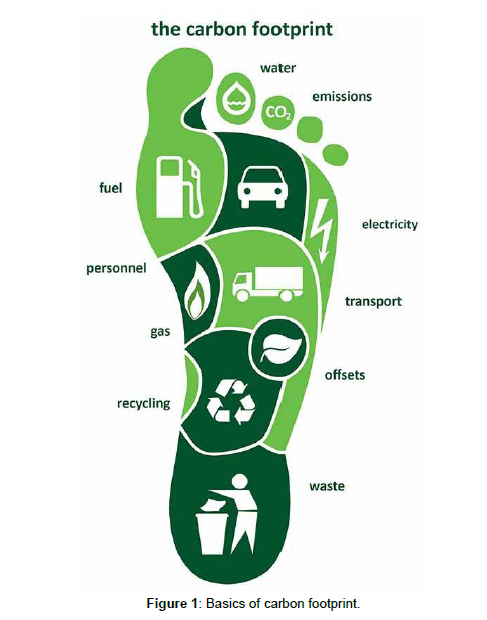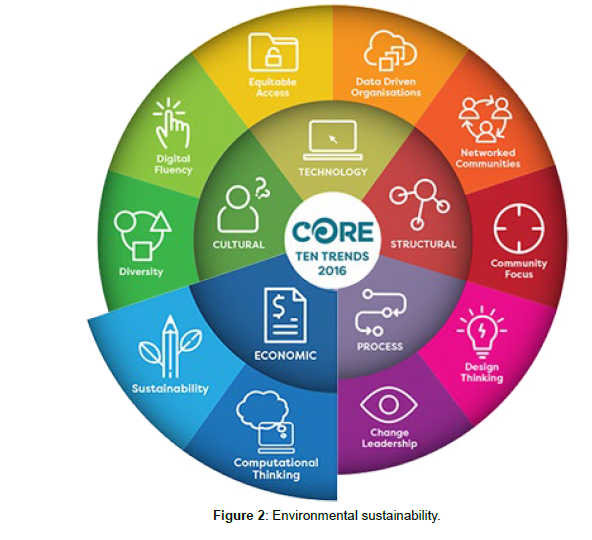Understanding Carbon Footprint: Taking Steps towards a Sustainable Future
Received: 03-Jul-2023 / Manuscript No. JEE-23-107002 / Editor assigned: 05-Jul-2023 / PreQC No. JEE-23-107002 (PQ) / Reviewed: 19-Jul-2023 / QC No. JEE-23-107002 / Revised: 22-Jul-2023 / Manuscript No. JEE-23-107002 (R) / Published Date: 29-Jul-2023 DOI: 10.4172/2157-7625.1000421
Abstract
In our pursuit of progress and development, the global community has inadvertently contributed to environmental challenges, particularly climate change. The concept of a "carbon footprint" has emerged as a crucial indicator of our impact on the planet. A carbon footprint measures the total greenhouse gas emissions produced by individuals, organizations, or activities. This article explores the significance of understanding and reducing our carbon footprint as we strive for a sustainable future.
Keywords
Carbon footprint; Sustainable future; Global community
Introduction
A carbon footprint quantifies the amount of greenhouse gases, mainly carbon dioxide (CO2), released into the atmosphere as a result of human activities. These emissions arise from burning fossil fuels, deforestation, industrial processes, and various other activities that contribute to the build-up of greenhouse gases in the atmosphere. The carbon footprint is typically measured in tons of CO2 equivalent (CO2e) per year [1-3].
Methodology
Sources of carbon footprint
Energy consumption: The burning of fossil fuels for electricity, heating, and transportation contributes to a significant portion of carbon emissions.
Transportation: Cars, trucks, planes, and ships are major contributors to carbon emissions. Fuel combustion in transportation releases CO2 and other greenhouse gases.
Industrial processes: Manufacturing, construction, and industrial activities release greenhouse gases through the use of fossil fuels, chemical reactions, and the release of industrial waste.
Agriculture and deforestation: Agricultural practices, including livestock farming and the use of synthetic fertilizers, produce methane and nitrous oxide. Deforestation further intensifies the carbon footprint by reducing carbon sinks (forests) and releasing stored carbon.
Impacts of carbon footprint
The accumulation of greenhouse gases in the atmosphere leads to global warming and climate change. Rising temperatures, extreme weather events, sea-level rise, and ecological disruptions are some of the consequences. The impacts of climate change extend to economic, social, and environmental spheres, affecting vulnerable communities, ecosystems, and biodiversity [4].
Taking steps towards a sustainable future
Reducing our carbon footprint is essential to mitigating the impacts of climate change and transitioning towards a sustainable future. Here are some steps we can take:
Energy efficiency: Enhance energy efficiency in buildings, appliances, and vehicles by adopting energy-saving technologies, reducing waste, and promoting renewable energy sources.
Sustainable transportation: Opt for public transportation, carpooling, cycling, or walking whenever feasible. Consider switching to electric or hybrid vehicles.
Renewable energy: Support and invest in renewable energy sources such as solar, wind, hydro, and geothermal power, reducing reliance on fossil fuels.
Waste reduction and recycling: Minimize waste generation and practice recycling to reduce the carbon emissions associated with waste disposal.
Sustainable consumption: Make conscious choices as consumers by opting for eco-friendly products, supporting local and sustainable businesses, and reducing overall consumption.
Reforestation and conservation: Protect and restore forests, which act as carbon sinks, by participating in reforestation efforts and supporting conservation initiatives.
Sustainable agriculture: Promote sustainable farming practices, reduce food waste, and support local and organic food systems.
Education and awareness: Spread awareness about the carbon footprint, climate change, and the importance of sustainable practices. Encourage others to take action (Table 1).
| Activity/Item | Carbon Footprint (in kg CO2e) |
|---|---|
| Driving a car (1 km) | 0.2 |
| Long-haul flight (per hour) | 80 |
| Electricity (1 kWh) | 0.5 |
| Meat and dairy (1 kg) | 13 |
| Vegetables and fruits (1 kg) | 2 |
| Paper (1 ream) | 6 |
| Plastic bottle (500 ml) | 0.12 |
| Smartphone (1 unit) | 55 |
| Laptop (1 unit) | 200 |
| Clothes (1 kg) | 20 |
Table 1: Carbon footprints of various activities and item.
Understanding and reducing our carbon footprint is vital for creating a sustainable future. By implementing the mentioned steps and embracing sustainable practices, we can collectively reduce greenhouse gas emissions and mitigate climate change. It is our responsibility to ensure a healthy planet for future generations, and reducing our carbon footprint is a significant step towards achieving that goal. Let us embrace sustainability and take action today for a greener and more sustainable tomorrow [5-8].
Assessing current carbon footprint
The first step in understanding and reducing carbon footprint is to assess the current emissions. This can be done at an individual, organizational, or community level. The methodology involves:
Gathering data: Collect data on energy consumption, transportation, waste generation, and other relevant activities. This can be achieved through utility bills, transportation logs, and waste management records.
Calculating emissions: Utilize carbon footprint calculators or software tools to quantify greenhouse gas emissions. These tools consider emission factors specific to each activity and convert them into CO2e units.
Identifying hotspots: Analyse the calculated data to identify areas or activities that contribute significantly to the carbon footprint. This information helps prioritize actions for emissions reduction (Figure 1).
Energy efficiency and renewable energy
Reducing energy consumption and transitioning to renewable energy sources play a pivotal role in reducing carbon emissions. The methodology involves:
Energy audit: Conduct an energy audit to identify areas of high energy consumption. Assess the efficiency of buildings, appliances, and transportation systems.
Energy conservation measures: Implement energy-saving measures such as insulation, LED lighting, efficient appliances, and smart energy management systems.
Renewable energy integration: Assess the feasibility of incorporating renewable energy sources like solar panels, wind turbines, or geothermal systems. Consider factors such as location, resource availability, and financial viability.
Sustainable transportation
Transportation is a significant contributor to carbon emissions. Implementing sustainable transportation strategies helps reduce the carbon footprint. The methodology involves:
Transportation assessment: Analyze transportation patterns, including commuting, business travel, and logistics. Gather data on fuel consumption, mileage, and vehicle efficiency.
Promoting alternatives: Encourage the use of public transportation, carpooling, biking, or walking. Provide incentives for employees to choose sustainable commuting options.
Electric vehicles (EVs): Evaluate the feasibility of adopting electric or hybrid vehicles for personal or fleet use. Install EV charging infrastructure if needed (Figure 2).
Waste reduction and recycling
Waste management practices significantly influence carbon emissions. The methodology involves:
Waste audit: Conduct a waste audit to understand the types and quantities of waste generated. Identify opportunities for waste reduction and recycling.
Waste minimization: Implement waste reduction strategies such as source separation, composting, and reducing packaging materials. Encourage employees, residents, or community members to participate in waste reduction initiatives.
Recycling programs: Establish or enhance recycling programs to divert recyclable materials from landfills. Collaborate with local recycling facilities to ensure proper handling of materials [9-11].
Sustainable agriculture and food systems
Agriculture and food production have a considerable impact on carbon emissions. The methodology involves:
Sustainable farming practices: Encourage farmers to adopt sustainable techniques such as organic farming, agroforestry, and efficient irrigation methods. These practices reduce greenhouse gas emissions from agricultural activities.
Local and organic food: Promote local and organic food systems to reduce emissions associated with long-distance transportation and synthetic fertilizers. Support farmers' markets, community-supported agriculture, and local food procurement policies.
Reforestation and conservation
Forests act as carbon sinks, absorbing CO2 and mitigating climate change. The methodology involves:
Reforestation initiatives: Collaborate with environmental organizations or government agencies to support reforestation projects. Participate in tree-planting campaigns or sponsor afforestation efforts.
Forest conservation: Protect existing forests from deforestation and degradation. Support conservation organizations, engage in sustainable forestry practices, and discourage illegal logging.
Education and awareness
Spreading awareness about carbon footprint and sustainable practices is crucial for driving change. The methodology involves:
Educational campaigns: Conduct workshops, seminars, or awareness campaigns to educate individuals, employees, or community members about carbon footprint and its implications. Highlight the importance of sustainable actions and provide practical tips for reducing emissions.
Behavioural change programs: Implement initiatives that promote sustainable behaviors, such as car-free days, energy-saving challenges, or waste reduction competitions. Encourage individuals or groups to track their progress and celebrate achievements.
Stakeholder engagement: Engage stakeholders, including employees, community members, and local businesses, in carbon reduction efforts. Foster collaboration, share best practices, and inspire collective action [12, 13].
Discussion
The article effectively highlights the importance of assessing current carbon footprints to identify areas for improvement. By quantifying emissions and identifying hotspots, individuals, organizations, and communities can prioritize actions and allocate resources effectively. This step sets the foundation for targeted mitigation efforts. The article also provides a comprehensive set of strategies to reduce carbon footprint across different sectors. It covers energy efficiency and renewable energy, sustainable transportation, waste reduction and recycling, sustainable agriculture, reforestation and conservation, as well as education and awareness. This range of approaches ensures that readers have a holistic understanding of the diverse ways they can contribute to carbon reduction efforts.
One notable strength of the article is its emphasis on individual and collective responsibility. It encourages readers to make conscious choices in their daily lives, such as adopting energy-efficient practices, supporting renewable energy, practicing sustainable transportation, and making informed consumption decisions. By emphasizing individual action, the article empowers readers to take tangible steps towards a sustainable future.
Conclusion
The article also recognizes the importance of collective action and stakeholder engagement. It emphasizes the need for collaboration among employees, communities, and businesses to drive change and foster a sustainable mind-set. The inclusion of education and awareness initiatives further strengthens this point, as spreading knowledge and inspiring behavioural change are essential components of addressing carbon footprints effectively. Furthermore, the article effectively highlights the broader implications of carbon footprints, such as climate change impacts, economic consequences.
References
- Benvenuto D, Giovanetti M, Ciccozzi A, Spoto S, Angeletti S, et al. (2020) The 2019-new coronavirus epidemic: evidence for virus evolution. J Med Virol 92: 455-459.
- Gu J, Gong E, Zhang B, Wu B, Shi X, et al. (2005) Multiple organ infection and the pathogenesis of SARS. J Exp Med 202: 415-424.
- Nagata N, Iwata-Yoshikawa N, Taguchi F (2010) Studies of severe acute respiratory syndrome coronavirus pathology in human cases and animal models. Vet Pathol 247: 881-892.
- Ridel KR, Gilbert DL (2010) Child neurology: past, present, and future. Part 3: the future. Neurology 75: e62-e64.
- Greenwood RS (2012) Changing child neurology training: evolution or revolution. J Child Neurol 27: 264-266.
- Gilbert DL, Horn PS, Kang PB, Mintz M, Joshii SM, et al. (2017) Child neurology recruitment and training: views of residents and child neurologists from the 2015 AAP/CNS workforce survey. Pediatr Neurol 66: 89-95.
- Ferriero DM, Pomero SL (2017) The evolution of child neurology training. Pediatr Neurol 66: 3-4.
- Harel S (2000) Pediatric neurology in Israel. J Child Neurol 10: 688-689.
- Majnemer A, Mazer B (1998) Neurologic evaluation of the newborn infant: definition and psychometric properties. Dev Med Child Neurol 40: 708-715.
- Mercuri E, Ricci D, Pane M, Baranello G (2005) Neurological examination of the newborn baby. Early Hum Dev 81: 947-956.
- Romeo DM, Bompard S, Cocca C, Serrao F, Carolis M, et al. (2017) Neonatal neurological examination during the first 6h after birth. Early Hum Dev 108: 41-44.
- Calamy L, Nicolet E (2018) Neonatal pain assessment practices in the maternity ward (delivery room and postpartum ward): We can improve! Arch Pediatr 25: 476-479.
- Prechtl HF, Einspieler C, Cioni G, Bos AF, Ferrari F, et al. (1997) An early marker for neurological deficits after perinatal brain lesions. Lancet 349: 1361-1363.
Citation: Dell C (2023) Understanding Carbon Footprint: Taking Steps towards a Sustainable Future. J Ecosys Ecograph, 13: 421. DOI: 10.4172/2157-7625.1000421
Copyright: © 2023 Dell C. This is an open-access article distributed under the terms of the Creative Commons Attribution License, which permits unrestricted use, distribution, and reproduction in any medium, provided the original author and source are credited.
Share This Article
Recommended Journals
Open Access Journals
Article Tools
Article Usage
- Total views: 862
- [From(publication date): 0-2023 - Mar 31, 2025]
- Breakdown by view type
- HTML page views: 639
- PDF downloads: 223


